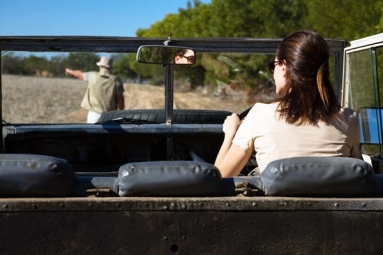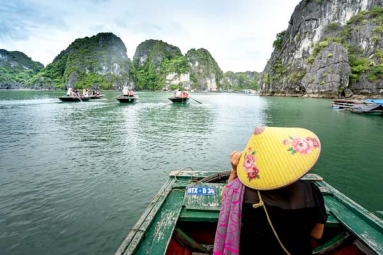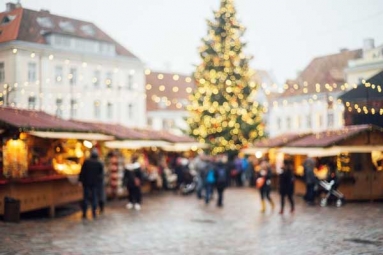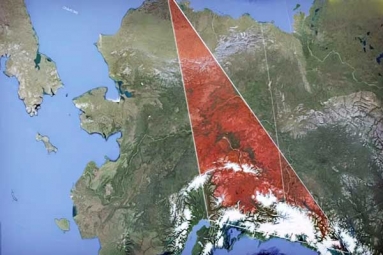
Most visitors to Alaska do not go to Nome…big mistake. This westernmost city on the North American continent offers more than a finish line for the Iditarod – the 1150-mile dogsled race that begins in Anchorage. A window exists in the short summer season to book a daily flight, rent a car, and drive three remote roads that give a glimpse of the vast tundra.
The savvy spotter can sight musk oxen, reindeer, as well as rare birds. Rainbows enshrine autumn’s colorful carpet during September, a month or so before giving way to a blanket of snow that lasts until spring. Let’s check out the town before hitting the road.
Revving for a Newfound Gold Rush
Nome has few restaurants, but many friendly bars. “This place is one big swamp in the summer,” a mineworker says over a cold one. “We get around a lot easier in 30 below when everything freezes.”
Astronomical gold prices attract rogue miners to pan for the precious metal along the Bering Sea’s shores. When officials chase them out, they rebuild shacks in a different spot, ready to move at a moments notice like nomads.
Large companies dredge the sea and sift for riches. Nome’s economy revives from construction companies rebuilding infrastructure for commercial mining operations. A typical household now adds a gold-pan device to accompany standard yard ornaments such as 4-wheel ATV’s, fishing gear, satellite dishes and reindeer racks.
“All those new gold panners do is take our gold,” a disgruntled mineworker says. “Then they complain about spending $5.00 for a shower.”
Teller Road
Downtown Nome: A lot more bars than restaurants. Downtown Nome: A lot more bars than restaurants.
The Bob Blodgett Nome-Teller Highway runs 72 miles one-way to the Eskimo village of Teller. All vehicle rentals in Nome come with 4-wheel drive. We soon find out why. Our rig slips and slides on the slick silicone washboard road. The real danger comes from the view, which pulls my gaze from watching the road ahead. Rainbows enshrine the maroon, yellow and orange carpet of this spongy tundra at the end of the earth.
We stand a good chance of spotting Musk Oxen, a beast that resembles one of our long-lost wolfhounds (minus the tusks). Herds of caribou and reindeer roam here, along with an occasional grizzly. The Inupiaq Community thrives on fishing. Salmon dries on wooden racks along side floatation vests that read, “Children don’t float. Please use one.”
We step out of the car and stare at the sea, trying to spot Russia’s Big Diomede Island, only 12 miles away. Of course, we see nothing through the mist.
Okay, the only Musk Oxen we spot this day was pummeled and picked by predators. We chase away the scavenging birds and photograph the animal’s skull, which happens to compliment the bouquet of tundra colors.
Council Road
Clouds and rain enhance the glow of whitecaps on top of a black/green Bering Sea. The road to Council through Solomon parallels the Bering’s coastline, where waves splash the sea wall and sprinkle our windshield. Commercial gold mining operations host projects to build better roads and breakers. Small homes on the beach provide a place to dry fish, escape in the summer and warm-up in winter when the athletic Iditarod sled dogs howl to the finish line. When the Bering Sea freezes, locals cut holes in the ice and drop crab pots to trap king crab.
Remnants of the once booming community of Solomon tell the town’s story on a memorial boardwalk. The Last Train to Nowhere rusts away, abandoned in 1907 after coming 20-miles short of the railroad’s goal to reach the town of Council. Envisioning a lively town full of saloons, hotels and miners during the 1800’s gold rush elicits an eerie feeling. Ferries once transported supplies, as well as influenza, which all but wiped-out the Eskimo Community of Inupiaqs. Most were buried in a mass grave in an unknown place under this tundra.
Birders and hunters flock to the backwaters, but where are the Musk Oxen?
Party Time
What are the odds of knowing someone in Nome? Almost another planet, this gateway to the Bering Land Bridge National Preserve holds artifacts of peoples dated up to 10,000 years old. We remember Jeremy, a traveler we had met a few years ago in the southernmost town on the South American Continent – Puerto Williams, Chile. He had just completed a MS in Recreation. (Wish they had that major when I was in college) He took a job in Nome, without even visiting the place.
“I’ve been here three years now,” Jeremy says. “My job is awesome.” He removes his hat and looks to be my son, if I had had one. “I never had luck with the ladies in the lower 48, but here… I don’t want to brag, but I’m a catch.” A curious silence at our table begs for more explanation. “I mean, I don’t beat women and I have a job.”
We laugh and order more drinks at the Husky restaurant, serving the best Japanese food in town.
Kougarok Road - Last Chance to Spot Musk Oxen
Kougarok Road snakes 85 miles up and through the heart of the Kigluaik Mountains towards the village of Taylor. Surely we’ll spot the elusive Musk Oxen today. The beasts have grown to a population of 2,000 after 70 of them were transplanted here over the last thirty years. Hunting and fishing shacks pop up along this remote road. It’s hard to believe that within one month, the change in season will blanket this vibrant, volcanic tundra with ice, snow and darkness.
Off the main road near Salmon Lake, we finally slip our rental car into 4-wheel drive. The climb over a lava rock-covered mountain provides a dark contrast for bright flowers. Mare walks in rubber boots ahead of our rig to gage the depth of mud puddle ponds on our way to Pilgrim Hot Springs. Soon the terrain transforms into an oasis of lush forest, surrounded by steaming ponds.
A fall rainbow near Nome, Alaska. Click photo to enlarge. A fall rainbow near Nome, Alaska.
“This machine drills 2-inch pipe 200 feet into the ground in 2 hours,” a Geologist says. “We’re hoping to convert this geological hot spot into electrical power for Nome.”
The path leads to an abandoned church and several dilapidated buildings. A caretaker for the Hot springs emerges from a shack. He explains that in the 1800’s a man farmed this land year round.
The boiling waters made it possible. When the farmer died, a Catholic Church gained the ground and opened an orphanage for children whose parents were wiped out by the 1918 influenza epidemic. “They cut down all the trees for firewood, but you can see they grew back.”
Mosquitoes love the hot springs in the tundra.
Rather than sit in a pond, we try a metal tub mounted on a platform. I strip down, slap bugs and try to submerge. I feel blisters about to form on the bottom of my feet – too hot. Mare snaps a photo, which resembles a pathetic Viagra commercial.
We head back out and up to the end of the road. Road construction crews must have scared off the Musk Oxen, and other wildlife. Although the end of this road feels anticlimactic, as you cannot drive to the town of Taylor, the hypnotic terrain of the tundra mesmerizes us during the return trip.
There Be Musk Oxen
Back in town Mare asks a woman, “Where do we find the rogue gold panners?”
“Down on west beach, past the containers,” says the young lady. “They ran them off of east beach.”
Off we go, around the containers, through the mud and debris, past the airport. Whoopee, Musk Oxen! After driving nearly 300 miles of tundra, we find the elusive beasts about a mile outside of town.
We celebrate in a local bar for a short while, and then grab a reindeer pizza and head for the couch, in our luxurious room overlooking the Bering Sea.




















